List of McDonnell Douglas F-4 Phantom II variants
Appearance
(Redirected fromRF-4C)

TheMcDonnell DouglasF-4 Phantom II variantswere numerous versions and designations of the F-4 and are described below.
Production numbers for major versions
[edit]| Aircraft | Number |
|---|---|
| F-4A | 45 |
| F-4B | 649 |
| RF-4B | 46 |
| F-4C | 583 |
| RF-4C | 503 |
| F-4D | 825 |
| F-4E | 1370 |
| F-4E 2020 (Turkey) | 54* |
| F-4EJ (Japan) | 140 |
| RF-4E | 149 |
| RF-4EJ (Japan) | 15* |
| F-4F | 175 |
| F-4G Wild Weasel | 134* |
| F-4J | 522 |
| F-4J Phantom F.3 (RAF) | 15* |
| F-4K Phantom FG.1 (FAA) | 50 |
| F-4M Phantom FGR.2 (RAF) | 116 |
| F-4N | 228* |
| F-4S | 302* |
asterisk indicates converted from other version
Variants
[edit]

- XF4H-1
- Two prototypes for theUnited States Navy,first flown 1958.
- F4H-1F (F-4A)
- Two-seat all-weather carrier-based fighter for the US Navy, J79-GE-2 and -2A engines with 16,100 lbf (71.6 kN) of afterburner thrust each. NamedPhantom IIin 1959 and redesignated F-4A in 1962; 45 built.[1]
- TF-4A
- A small number of F-4As converted into two-seat training aircraft.
- F4H-1 (F-4B)
- Two-seat all-weather carrier-based fighter andattack aircraftfor the US Navy and Marine Corps. J79-GE-8A or -8B engines with 16,950 lbf (75.4 kN) of afterburner thrust each. Redesignated F-4B in 1962; 649 built.[2]
- DF-4B
- F-4Bs converted intodronecontrol aircraft.
- EF-4B
- One F-4B converted into anECMtraining aircraft.
- NF-4B
- The redesignation of one F-4B for testing purposes.
- QF-4B
- F-4Bs converted into unmanned supersonic target drones; 25 converted.
- F4H-1P (RF-4B)
- Tactical reconnaissance version of F-4B forUnited States Marine Corps,nose stretched 4 ft 9 in (1.4 m), smaller AN/APQ-99 radar. Three camera bays typically carried KS-87 forward oblique/vertical camera on Station 1, KA-87 low-altitude camera on Station 2, and KA-55A or KA-91 high-altitude panoramic camera on Station 3. Also carried AN/APQ-102 reconnaissanceSLAR,AN/AAD-4infrared reconnaissance system,andALQ-126ECMsuite. The KS-72 or KS-85 cameras were on rotating mounts and could be aimed in flight which improved upon the earlier RF-4C which could only be aligned on the ground.[3]In 1975, modernized underProject SURE(Sensor Update and Refurbishment Effort); 46 built. Retired in 1990. 4 lost in Vietnam.[4]First flown 12 March 1965.[5]

- F-110A
- The original US Air Force designation for the F-4C.
- F-4C
- Two-seat all-weather tactical fighter, ground-attack version for theUnited States Air Force;supported a wide spectrum of weapons includingAIM-4 Falcon,AGM-12 Bullpup,and nuclear weapons; wider main wheel tires resulted in distinctive wing bulges;J79-GE-15engines with provision for cartridge start;boom refuelinginstead of Navy'sprobe and drogue refueling;AN/APQ-100radar; duplicated flight controls in the rear cockpit. The aircraft exceeded Mach 2 during its first flight on 27 May 1963; 583 built.
- EF-4C Wild Weasel IV
- F-4Cs converted intoWild WeaselECM aircraft. Equipped withAN/APR-25RHAWS,AN/APR-26missile launch warning system,ER-142ECM receiver, andAN/ALQ-119external ECM pod. Armed withAGM-45 Shrikeanti-radiation missiles and cluster bombs but unable to carry theAGM-78 Standard ARMmissile. A total of 36 were converted.[6]Many survivors were reverted to F-4C.
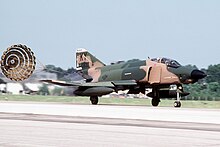
- RF-4C
- All-weather tactical reconnaissance version for the US Air Force, AN/APQ-99 (laterAN/APQ-172) radar. Equipped similar to RF-4B but with a wider choice of camera fits, including a centerline pod for the giganticHIAC-1LOROP(Long Range Oblique Photography) camera, capable of taking high-resolution images of objects 100 miles (160 km) away. Many aircraft were refitted with a more spacious bulging streamlined nose. A sub-variant, to be designatedRF-4C(H)was proposed as a night "hunter" aircraft usinginfrared equipmentinstead of cameras underOperation Shed Light.In the end, none were converted. While usually unarmed, RF-4Cs retained the ability to carry a nuclear weapon on the centerline pylon. Additionally, the RF-4Cs of the Alabama Air National Guard, Nevada Air National Guard and Fighter Weapons School were modified to carry the AIM-9 Air to Air Missile. These modernized RF-4Cs of the Alabama and Nevada Air National Guard extensively participated in theGulf War;503 built.
- Two RF-4Cs shot down by USSR duringProject Dark Genewhilst being flown by USAF pilots.[7]
- YRF-110A (YRF-4C)
- Two prototypes were used in the development of the RF-4C reconnaissance version.
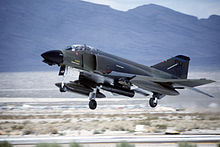
- F-4D
- F-4C with updated avionics,AN/APQ-109radar. First flight June 1965. One USAF pilot and two USAF WSOs becameacesin F-4Ds; 825 built.[8]
- EF-4D Wild Weasel IV
- F-4Ds converted into Wild Weasel ECM aircraft. Unlike the EF-4C, the EF-4D had the capability to use the largerAGM-78 Standard ARM.Only 2 converted.[9]
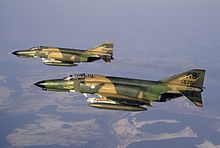
- F-4E
- USAF version with an integralM61 Vulcancannon in the elongated RF-4C nose,AN/APQ-120radar with smaller cross-section to accommodate the cannon, J79-GE-17 engines with 17,900 lbf (79.379 kN) of afterburner thrust each. Late-series aircraft equipped with leading-edge slats to improve maneuverability at the expense of top speed under theAgile Eagleprogram. Starting with Block 53, aircraft addedAGM-65 Maverickcapability and smokeless J79-GE-17C or -17E engines. First flight 1 August 1965. The most numerous Phantom variant; 1,370 built.
- F-4E Kurnass 2000
- Modernized Israeli F-4Es,AN/APG-76radar. Contained new avionics, screens, HUD, wiring, digital communication bus. Support for standoff weapons became standard whereas with F-4Es each weapon required different wiring modifications. Entered service in 1989, retired in 2004.
- F-4E Peace Icarus 2000 (AUP)

- In 1998 theHellenic Air Forcedecided, in collaboration with theGerman Aerospace Industry (DASA)and theHellenic Aerospace Industry (HAI/EAB),to upgrade 39 F-4E Phantom II fighters. The first aircraft was delivered atAndravida Air Basein December 2002. All upgraded F-4s were equipped with the new AN/APQ-65YG radar similar to that of theF/A-18 Hornet,a new onboard Mission Control Computer (MCC), aHead Up Display,theIFFInterrogator,Multi Function Displaysand were also capable of carrying a variety of advancedAir-to-AirandAir-to-Groundmissiles. These included theAIM-120 AMRAAM(although only the -B edition), theAIM-9Mmissile, the AFDS and the entire family of thePaveway(I, II and III)laser-guided bombs.Although gradual retirement of F-4 units started in 2017, a number of aircraft are still operational in multi-role missions with the 338 Squadron”Ares”and the 339 Squadron"Ajax”based in Andravida Air Force Base.[10]The F-4E Phantom II PI2000 (AUP) has also been certified for use ofGBU-27 Paveway IIIlaser-guidedbombs.
- F-4E Terminator 2020
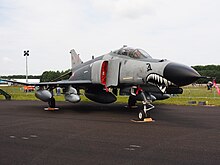
- The latest in a long line of F-4 variants, the Terminators are a batch ofTurkish Air ForceF-4Es, modernized by Israel on the pattern of the Kurnass 2000. They differ from the existing F-4E airframe in a number of key areas, including new attachment fittings to better handle modern weaponry, stronger wing fold ribs, an updated canopy sill bar, and the replacement of some 20 km of wiring (reducing weight by 750 kg) as well as most hydraulic and pneumatic lines and hoses.[11]A plan to increase the turn-rate and longitudinal stability of the Kurnass/Terminator derivatives through the installation of fuselage strakes over the engine inlets was abandoned after testing, and never saw installation on operational aircraft.[12]
- The most radical changes occurred in the avionics department. All 2020s have been fitted with vastly updated suite, including MFDs (multifunction displays) as standard, and incorporating a number of new technologies, such as the new Kaiser El-OP 976 wide-angleHUDandHOTASsystem, high performanceEltaEL/M-2032ISAR-capable high-resolution SAR/GMTI (ground moving target indicator) multi-mode fire control radar (developed for theIAI Lavi), IAIC mission computer, new navigation equipment includingGPS/INSconnected to mapping mode, dual MIL-STD-1553B databus managing avionics package, Astronautics Central Air Data Computer, new UHF and IFF packages, airborne video tape recorder (AVTR), Elta EL/L-8222 activeECMpod, Mikes (Aselsan) AN/ALQ-178V3 passive embedded SPEWS, andRWR.[11][13]
- Additionally, they receivedAGM-142 Popeye/Have Napintegration,Litening-IItargeting pods, and the capability to launchAGM-65D/G Maverick,AGM-88 HARM,GBU-8 HOBOS,GBU-10/12 Paveway IILGBs,general purpose andcluster bombsfor air-to-ground missions, while retaining the capability to launchAIM-7 SparrowandAIM-9 Sidewinderair-to-air missiles. It is also possible to installPave Spiketargeting pods and rocket pods of all sizes.[11][13]
- These upgraded F-4 Phantoms are referred to as theF-4E-2020 Terminator.54 were modernized and 30+ of them will be in service until at least 2030.[14]They first entered service on 27 January 2000 with deliveries to 111 and 171 Filo.[15]
- QF-4E
- Remote-controlled targetdrone.
- F-4EJ

- Two-seat all-weather air defense fighter version of F-4E, initially lacked ground attack capability. Built under licence inJapan,byMitsubishi Heavy Industriesfor theJapan Air Self-Defense Force;140 built (138 by Mitsubishi).
- F-4EJ Kai
- Upgraded version of the F-4EJ with improved avionics, includingAN/APG-66J pulse-doppler radar, and ground attack capability, includingASM-1anti-ship missile.
- EF-4EJ
- Small number of F-4EJs were converted into ECM training aircraft.
- F-4E(S)
- ThreeIsraeliF-4E modified for high-speed reconnaissance as a cheaper alternative to the ambitious F-4X. Fitted with a new nose containing the HIAC-1 LOROP long-range camera with a 66-in (168 cm)focal lengthas well as a vertical KS-87 camera. The aircraft had a false radome painted on the nose to resemble conventional F-4Es. The fate and service record of these aircraft is unknown.[16]
- RF-4E

- Unarmed reconnaissance version for export only. Retrofitted to carry weapons by most customers. SeveralGerman Air Forceaircraft were modified forELINTmissions underPeace Troutprogram; 149 built.
- RF-4EJ
- Modified Japanese F-4EJ to operate reconnaissance equipment. Unlike RF-4E, M61 Vulcan is mounted in the nose. 15 converted.

- YF-4E
- One of the original YRF-4C prototypes was converted into the YF-4E. The YF-4E was used in the development of the F-4E fighter as well as infly-by-wirePrecision Aircraft Control Technology(PACT) andControl Configured Vehicle(CCV) test programs. Three conversions.
- F-4F
- F-4E for German Air Force with simplified equipment, no Sparrow capability; 175 built.
- F-4F ICE
- (Improved Combat Efficiency) Upgraded F-4F with AN/APG-65 radar and AIM-120 AMRAAM capability.
- TF-4F
- German trainer aircraft, with pilot instructor aft station and appropriate controls.
- F-4G
- US Navy version, 12 F-4Bs were fitted with the AN/ASW-21 data link digital communications system for automatic carrier landings,[17]one shot down by enemy ground fire, the surviving 11 returned to F-4B configuration.[18]

- F-4G Wild Weasel V
- F-4E converted toSEADaircraft for the US Air Force.AN/APQ-120radar, their cannon replaced by the APR-38 RHAW[19]and later the AN/APR-47,[20]several ECM pods including the ALQ-87, ALQ-101, ALQ-119, ALQ-130, ALQ-131, and the ALQ-140 IR jammer, the ability to carryAGM-45 Shrike,AGM-78 Standard,andAGM-88 HARManti-radiation missiles. Widely used during theGulf War,Operation Provide Comfort,andOperation Southern Watch;116 converted initially, with a further 18 F-4Es converted as attrition replacements for a total of 134.
- QF-4G
- Remote-controlled target drone.
- F-4H
- Designation not used to avoid confusion with the pre-1962 F4H.[21]

- F-4J
- Improved F-4B version for US Navy and Marine Corps, with emphasis on air-to-air combat capability improvement, which include: J79-GE-10 engines with 17,844 lbf (79.374 kN) of afterburner thrust each,AN/APG-59pulse doppler radar coupled with theAN/AWG-10Fire Control System for look-down shoot-down capability, larger main landing gear wheels resulting in wing bulges similar to F-4C, slatted tailplane, ailerons drooped 16.5° when landing gear and flaps were deployed to decrease the landing speed, zero-zeroejection seats,expanded ground attack capability, noIRSTsensor under the nose; One USN pilot and one USN Naval Flight Officer became aces in F-4Js. First flight May 1966; 522 built.
- F-4J(UK) Phantom F.3
- Designation of 15 low airtime F-4J aircraft purchased by theRoyal Air Forcefrom the US Navy in 1984, upgraded to F-4S standard with some British equipment. Although designatedPhantom F.3by the RAF,[22][23]the aircraft was often referred to as F-4J(UK). Used until 1991 byNo. 74 Squadron RAFonly for UK air defense in lieu of Phantoms sent to Falklands.
- DF-4J
- One F-4J converted into a drone control aircraft.
- EF-4J
- Two F-4Js converted into ECM training aircraft.
- YF-4J
- Three F-4Bs were converted into YF-4J prototypes. The YF-4Js were used in the development of the F-4J.

F-4 Phantom comparisons
F-4E Phantom
F-4K Phantom
- F-4K Phantom FG.1
- F-4J version forFleet Air Armof theRoyal Navyto replace theDe Havilland Sea Vixen.[24]Operated as thePhantom FG.1(Fighter/Ground attack). Folding nose and extending nosewheel leg. Re-engined with the more powerful BritishRolls-Royce Spey202turbofanengines which required an enlarged fuselage but gave more power taking off from smaller carriers and was already in use withBlackburn Buccaneeron RN carriers. Delivered from 1968, with cancellation of planned carriers order cut and 20 diverted to theRoyal Air Forcebefore going into service; 50 built. RN aircraft withdrawn by 1978 and passed to RAF.
- YF-4K
- Two prototypes, used in the development of the F-4K.
- F-4L
- Designation applied to several proposals for an advanced version, includingModel 98FOAwith RR Spey turbofan engines andAIM-54 Phoenixmissiles.
- F-4M Phantom FGR.2
- Tactical fighter, ground-attack, and reconnaissance aircraft developed from F-4K for theRoyal Air Force,UK designationPhantom FGR.2,ordered after cancellation of theHawker Siddeley P.1154supersonic V/STOL aircraft. RR Spey turbofan engines; 116 built. ReplacedEnglish Electric CanberraandHawker Hunter.Replaced in turn bySEPECAT Jaguarin ground-attack mission; replacedEnglish Electric Lightningin air defense role.
- YF-4M
- Two prototypes used in the development of the F-4M.

- F-4N
- F-4B modernized under projectBee Line,the same aerodynamic improvements as F-4J, smokeless engines. First flight 4 June 1972; 228 converted.
- QF-4N
- F-4Ns converted into remote-controlled supersonic target drones.
- F-4S
- F-4J modernized with smokeless engines, reinforced airframe, leading-edge slats for improved maneuverability. First flight July 1977; 302 converted.
- QF-4S
- F-4S converted into supersonic target drones.
- F-4E/TM Şimşek (Lightning)
- F-4E modernised byASELSANfor the Turkish Air Force, with structural and avionics upgrades. Sixteen upgraded from 2010.[25]
- RF-4E/TM Işık (Light)
- RF-4E modernised by ASELSAN for Turkish Air Force, with structural strengthening, improved avionics and a new reconnaissance pod. Eighteen upgraded from 2009.[26]
Proposals
[edit]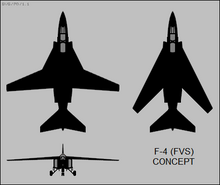
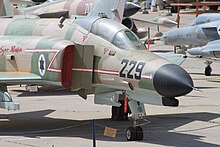
- F4H
- Proposed ground attack variantsModel 98DAandModel 98DBfor US Army to take off from grass field/forward air base powered by Allison Spey (AR-168), modified from F4H-1; none built.[27]
- F-4E(F)
- Proposed single-seat simplified version of F-4E for the German Air Force; none built.
- F-4L
- ProposedAIM-54 Phoenixcapable advanced Phantom variant (Model 98FOA) offered to the US Navy in 1963/64 as a replacement for theF-8 Crusaderin the fleet defense role[28]The F-4L had an increased wingspan and powered byAllison TF41-A-2 turbofans for quicker acceleration taking offEssex classcarriers.
- RF-4M
- Proposed, dedicated reconnaissance variant of the F-4M for the RAF; intention to fit equipment internally rather than through carriage of external reconnaissance pod. Not proceeded with.[29]
- F-4T
- Proposed lightweight air superiority-only fighter version; none built.[30]
- F-4 (FVS)
- Proposed version with airframe modified byGrummanto usevariable geometry wings;none built.
- F-4X
- Proposed high-performance reconnaissance version with HIAC-1 LOROP camera for Israel developed under thePeace Jackprogram in conjunction with General Dynamics. Water injection was projected to give the aircraft a top speed in excess of Mach 3 (over 2,000 mph (3,200 km/h) at high altitudes). The water would be contained in a pair of 2,500 US gal (9,600 L) conformal tanks on the sides of the fuselage spine. The US State Department became worried about developing an aircraft with performance similar to theSR-71 Blackbirdand offensive capability beyond anything in domestic inventory for a foreign customer and forbade its export. The proposal was then modified to theRF-4Xstandard with the camera in the nose and removal of weapon carriage. However, the US Air Force withdrew from the project over concerns that a high-performance Phantom would jeopardize funding for the anticipatedMcDonnell Douglas F-15 Eagle.Without United States financial support, Israel settled for the simpler, less expensive F-4E(S), which was given the nickname 'Shablool', or 'Snail'.[16]
- Boeing Super Phantom
- A 1984 joint venture between Boeing and Pratt & Whitney for a Phantom variant withPratt & Whitney PW1120turbofanengines, giving a significant performance gain over J79 Phantoms. The aircraft would also have an 1,100 US gal (4,230 L) conformal fuel tank under the fuselage.[31]Cancelled early in development.[32]
- IAI Super Phantom
- A separateIsrael Aircraft Industriesproject was proposed for a PW1120-powered Phantom,[33]and one prototype built.[34]IAI's F-4 "Super Phantom" or F-4-2000, which could exceed Mach 1 without afterburners, was displayed at the 1987 Paris Air Show.
See also
[edit]References
[edit]Notes
[edit]Citations
[edit]- ^Francillon 1979,p. 559
- ^Francillon 1979,p. 559-560
- ^Sweetman & Bonds 1987,p. 531
- ^Dorr 1987,p. 39
- ^Eden 2004,p. 278
- ^Francillon 1994,p. 15-17, 20
- ^"Project Ibex and Project Dark Gene".www.spyflight.co.uk.Archived fromthe originalon September 24, 2015.RetrievedJune 30,2012.
- ^Dorr & Donald 1990,p. 194
- ^FrancillonAir InternationalJuly 1994, p.17.
- ^"338 Μοίρα Δίωξης – Βομβαρδισμού;".Haf.gr.Archivedfrom the original on March 1, 2009.RetrievedJuly 29,2009.
- ^abcF-4 Phantom on the "warriorsoul"Archived2008-02-29 at theWayback Machine,Turkish Armed Forces website, Retrieved: 8 February 2008
- ^Klein and Aloni, Andreas and Schlomo (2009).The 'Kurnass' in IDF/AF Service 1989 until Today.Double Ugly Books.
- ^abDonald & Lake 1996
- ^"ABD'den olumlu sinyal alamayan Türkiye, F-4'lerin emekliliğini 2030'a erteledi"(in Turkish). November 18, 2021.
- ^Phantom for TurkeyArchived2008-05-02 at theWayback Machine,J Baugher, May 20, 2000.
- ^abMiller 1985,p. 19-25
- ^"Remembering the U.S. Navy F-4G, the Phantom That Could Perform Automatic Carrier Landings".February 8, 2018.
- ^Francillon 1994,p. 17-20
- ^"Federation of American Scientists:: F-4 Phantom II/F-4G Advanced Wild Weasel".Archived fromthe originalon October 21, 2013.RetrievedApril 4,2015.
- ^"Factsheets: McDonnell Douglas F-4G Wild Weasel".Archived fromthe originalon January 2, 2014.RetrievedMay 10,2014.
- ^Francillon 1979,p. 568
- ^"RAF timeline 1980–1989".Royal Air Force.Archived fromthe originalon August 31, 2013.RetrievedMarch 23,2015.
No 74 Squadron reforms at Wattisham with the delivery of the first of the F4J Phantoms, given the RAF designation Phantom F3
- ^"No 74 Squadron".National Cold War Exhibition.Royal Air Force Museum.Archived fromthe originalon May 17, 2016.RetrievedMay 17,2016.
- ^"The Royal Air Force - History Section".Archived fromthe originalon November 22, 2007.RetrievedSeptember 21,2007.
- ^Mevlutoglu 2011,p. 44
- ^Mevlutoglu 2011,p. 45
- ^https://www.secretprojects.co.uk/ebooks/McDonnell%20Model%20Numbers%20List.pdf[bare URL PDF]
- ^"McDonnell F-4L Phantom II".
- ^Simmelink, Kim (November 20, 2013)."Phantoms that never were built… RF-4M".Phantom Phacts.RetrievedJune 9,2016.
- ^https://www.uswarplanes.net/f4.pdf[bare URL PDF]
- ^Spick 1985,p. 289-290
- ^"Boeing" Super Phantom "".July 25, 2008. Archived fromthe originalon July 25, 2008.
- ^Spick 1985,p. 290-291
- ^"[3.0] Phantom In Foreign Service".www.faqs.org.
Bibliography
[edit]- Baugher, J"McDonnell F-4 Phantom II",American Military Aircraft
- Donald, David; Lake, Jon, eds. (1996).Encyclopedia of World Military Aircraft.London: AIRtime Publishing.ISBN1-880588-24-2.
- Dorr, Robert F.; Donald, David (1990).Fighters of the United States Air Force.London: Temple Press/Aerospace.ISBN0-600-55094-X.
- Dorr, Robert F. (1987).Phantoms Forever.London: Osprey Publishing Limited.ISBN0-85045-742-4.
- Eden, Paul, ed. (2004).The Encyclopedia of Modern Military Aircraft.London: Amber Books Ltd.ISBN1-904687-84-9.
- Francillon, René J. (1979).McDonnell Douglas Aircraft since 1920.London: Putnam.ISBN0-370-00050-1.
- Francillon, René J. (July 1994). "Wild Weasel Phantoms".Air International.Vol. 47, no. 1. Stamford, UK: Key Publishing. pp. 15–21.
- Mevlutoglu, Arda (January 2011). "Anatolian Phantoms".Air International.Vol. 80, no. 1. pp. 40–45.ISSN0306-5634.
- Miller, Jay (July 1985). "Peace Jack: An Enigma Exposed".Air International.Vol. 29, no. 1. Bromley, UK: Fine Scroll. pp. 18–23.
- Spick, Mike (December 1985). "2001 Phantom Odyssey".Air International.Vol. 29, no. 6. Bromley, UK: Fine Scroll. pp. 287–292.
- Sweetman, Bill; Bonds, Ray (1987).The Great Book of Modern Warplanes.New York, New York: Crown Publishers.ISBN0-517-63367-1.


